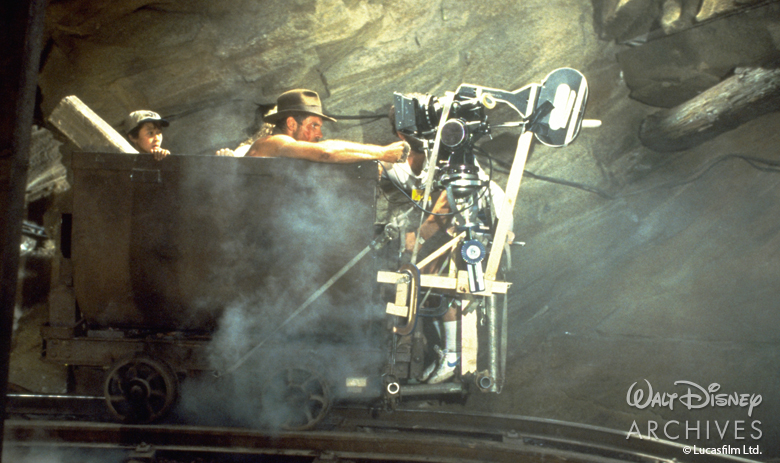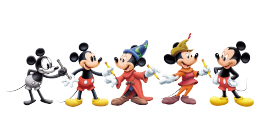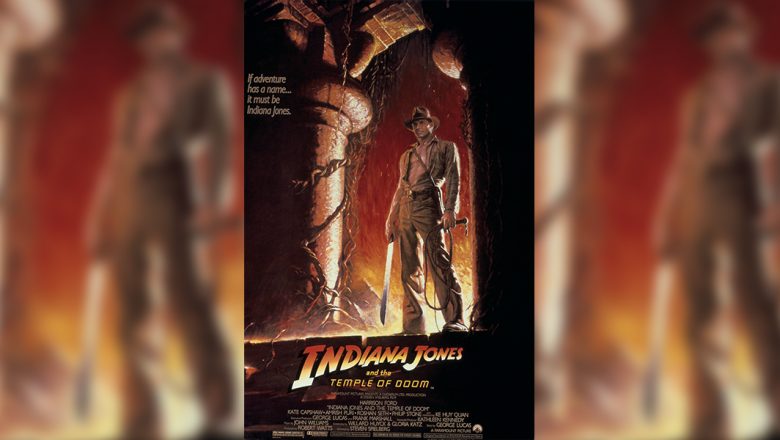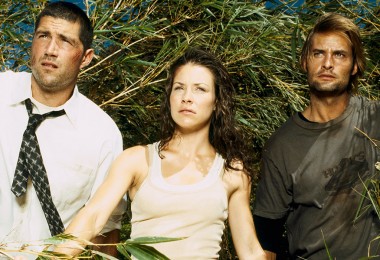By Francesca Scrimgeour, Walt Disney Archives
Hold on to your potatoes, Indiana Jones and the Temple of Doom released this month on May 23, 1984! Inspired by the adventurous Republic Pictures film serials of the 1930s, 40s, and 50s, director Steven Spielberg and executive producer George Lucas brought their dynamic filmmaking minds together to create this second installment in an episodic series about a daredevil archaeologist and his exploits. Indiana Jones and the Temple of Doom is packed with action and brings back our leading adventurer, Indiana Jones, played by Harrison Ford, with new companions Willie Scott, played by Kate Capshaw, and Short Round, played by Ke Huy Quan. The ragtag trio meets a steady stream of perils from the back streets of Shanghai to the dense jungles of India, leading them through a maelstrom of danger. Interestingly, some sequences that were originally planned for Indiana Jones and the Raiders of the Lost Ark, the first film in the series, were used for Indiana Jones and the Temple of Doom. The two scenes that were storyboarded but not included in the preceding film were the breathtaking river rafting scene and the thrilling mine cart chase.

The filmmakers had to use innovative cinematography to film the live-action mine cart chase scene since they wanted to portray miles of track for Indiana Jones and his fellow explorers to careen down. However, to do this the crew would have to build a mine tunnel set that would have taken up multiple soundstages, so production designer Elliot Scott built a circular track on several levels to make it look like the fortune hunters were barreling through different caverns. By the team changing the lighting from red to yellow, the viewer would never know it was the same cavern. A few of the scenes in the mine cart chase couldn’t be done realistically due to the size of the set, hence the special effects artists and technicians at Industrial Light & Magic (ILM) were brought in to make the scene grander. An additional six months were spent building and filming an exact miniature of the full-scale set in England. Small stop-motion figures were created, which Visual Effects Supervisor Dennis Muren and the animation crew slowly repositioned, with each frame taking about one to five minutes. This resulted in hours of shooting specific shots that would last four or five seconds on screen.

The larger-than-life flick was filmed across three different continents. Producer Robert Watts had the task of scouting out locations, and he chose the island of Sri Lanka, off the coast of India, for its rugged jungles and lush valleys. According to Watts, Sri Lanka had not been used a great deal for movie locations; however, prior to this film, one of the most famous movies filmed in this location was The Bridge on the River Kwai, of which Steven Spielberg was a fan, and he relished the opportunity to film in the same space. Additionally, the streets of the city of Macao on the south coast of China were used for the high-speed car chase sequence. For different scenes that could not be captured on location, imaginative sets were created at Elstree Studios in Borehamwood, outside of London, which included the Temple of Doom itself, the extravagant feast in the Palace of Pankot, and the menacing spike chamber. Additional sequences were shot in Northern California, including Hamilton Air Force Base which doubled as the Shanghai Airport, and at ILM’s facility in Marin County, where the blue-screen scenes were filmed.

Interestingly, one scene was even shot on three different continents. The rope bridge sequence started filming in Sri Lanka, continued in England, and finished in the United States. The production crew was able to keep the scene together through the storyboards prepared by Steven Spielberg. In Sri Lanka, there was a gorge next to the construction site of a large dam with a copious number of engineers that were hired to create a suspension bridge. Robert Watts noted, “Once the bridge was up, we dressed it to look old and rickety.” After filming the numerous shots of the cast on the bridge, Indiana Jones made the quick decision to cut the bridge, which was shot in one take. The crew made sure to have numerous cameras in the gorge to get every possible angle since they only had one take. Electronic explosives were installed into the bridge with mechanical dummies to make the scene more realistic, and a layer of dust was added to give the scene extra flare. To add to the realism of the scene, the mechanical dummies were rigged to flail and kick their limbs as they fell more than 300 feet into the canyon. For the close-up shots of the actors climbing hand-over-hand to escape the fall, sets were created to capture those shots at Elstree Studios outside of London, and for the close-up shots of the alligators at the bottom of the gorge, a filming crew was sent to Florida to record the reptiles.

As the second installment of the Indiana Jones series, Indiana Jones and the Temple of Doom was going to be a lot darker than its predecessor, Indiana Jones and the Raiders of the Lost Ark. According to George Lucas and Steven Spielberg, the Indiana Jones series would parallel the Star Wars films, especially The Empire Strikes Back, and have a darker story plot, thus, making the film, in their eyes, edgier. Steven Spielberg said it best: “This picture is not called the Temple of Roses, it’s called the Temple of Doom, the warning is clearly marked on the box.” This film was a more serious and dangerous adventure for Dr. Jones which led our hero into a series of nightmares. One of the most intense scenes of the film was inside the Temple of Doom, where the fearsome Mola Ram, played by Amrish Puri, sacrifices a victim by pulling out his heart and lowering him into the lava pit. Special effects supervisor George Gibbs took this scene to the next level by creating an audio-animatronic for the sacrificial victim in the scene. However, on the word of Spielberg, the scene was deemed too gruesome, so instead of losing the scene completely, he asked ILM to add some flames to cover up the effect a bit. With all that being said, this movie was rated PG (Parental Guidance Suggested) by the Motion Picture Association because, at the time, the next rating up was R (Restricted). This film helped prompt the Motion Picture Association to create a brand-new PG-13 (Parents Strongly Cautioned) rating on the suggestion of Steven Spielberg, who personally called the head of the Motion Picture Association of America, Jack Valenti, to make the case.

According to Steven Spielberg, the character of Indiana Jones was considered a rough-and-tumble adventurer, however, George Lucas had been asking for Indiana Jones to have a scene where he could be more suave and debonair. Spielberg realized this charming and refined version of Indiana Jones in the opening of the film, as the tuxedo-sporting hero sauntered into “Club Obi Wan” after the Busby Berkeley-type dance number. The beginning of the film is truly the third act climax of an unseen Indiana Jones adventure, which hooks the audience into the spirit of Indiana Jones. Kate Capshaw, who played Willie Scott, had to learn to sing in Mandarin as well as dance for the number; however, her stunning red dress was so tight, she wasn’t able to perform the dance. The one-of-a-kind evening dress was designed by Anthony Powell and was made of original 1920-1930s beads and sequins. The dress was only scheduled to be used for the dance number, which was one of the last sequences to be filmed. The decision was made to hang the dress in a tree during the encampment scene for the continuity of Willie Scott holding on to her dazzling gown. Unexpectedly, an elephant on set got a hold of it and ate out the back of the costume. Luckily, they had just enough beads to repair the costume, but costume designer Anthony Powell noted the hilarity of filling out the insurance forms and having to hold an elephant responsible for the damage.
The thrilling Indiana Jones and the Temple of Doom was an imaginative addition to the lore of Indiana Jones and brought audiences along for a rip-roaring adventure. The film has daring feats and a plethora of slimy pests that have kept fans on the edges of their seats for 37 years, but as Indiana Jones himself says, “That’s why they call it the jungle, sweetheart.”






